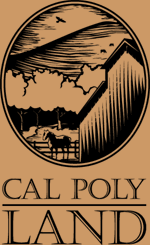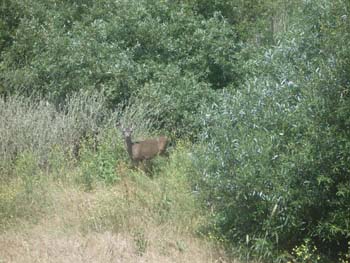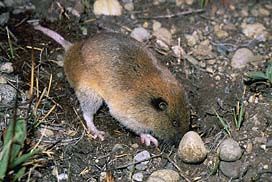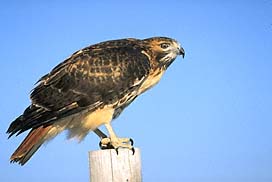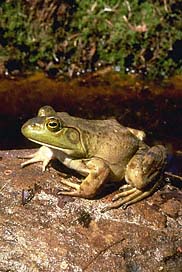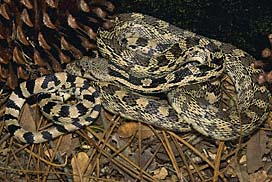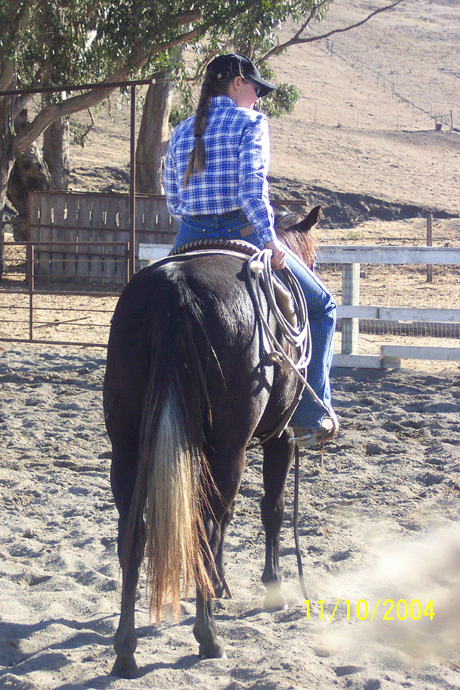|
Animals
|
|
|
|
|
|
The wildlife found on the grounds of the Equine Center are categorized by Mammals, Birds, Amphibians, and Reptiles. Animals play a role in fertilizing soils and distributing seeds for vegetative growth throughout the territory. They are very much a part of the Equine Center and its thriving environment. White-tailed deer Odocoileus virginianus
This is a small to medium size deer, with a white belly, throat, nose, eye ring, and lining inside ears. The deer has a tail with a brown edge and white fur above. There is often a dark stripe down the center. The deer commonly has black spots on the side of its chin. It may carry ticks that transmit lyme disease, a dangerous bacterial illness. The species is a good swimmer and runner, with top speeds of 36 mph. The white-tailed deer inhabits farmlands, brushy areas, woods, suburbs and gardens. Bobcats Lynx rufus (Felis rufus)
The bobcat's face has thin, broken black lines that radiate onto its cheek ruff. It has a short stubby tail consisting of 2 or 3 black bars and a black tip at the end. The male bobcat is larger than the female. It gets its name from the stubby or "bobbed" tail that it has. The varying calls of the bobcat may sound similar to the calls of a domestic cat, however the scream is much more piercing. The bobcat primarily inhabits scrubby country or broken forests—hardwood, coniferous, or mixed; also swamps, farmland, and rocky or brushy arid lands in North America, where it is the most common wildcat. Ground Squirrels Spermophilus beecheyi
Ground squirrels are mostly brown with a whitish wash from the side of their neck that travels across the shoulders and forelegs. They have somewhat bushy tails which are brownish gray on top and edged with white. The squirrel hibernates from November to February and primarily feeds on plant material, including leaves, stems, flowers, bulbs, roots, seeds, fruits, and berries; it often damages grain, fruit, and nut crops. These squirrels may form loose colonies in some places, but individuals tend to be antisocial. Mostly the ground squirrel inhabits open areas including rocky outcrops, fields, pastures, and sparsely wooded hillsides. Western Pocket Gophers Thomomys mazama
The Western Pocket gopher spends a great deal of time above the ground mostly at night. Yet it can also be found above ground on warm, dark days. They are reddish brown in color or various shades of gray to black, depending on the soil color. They have a pointed ear with a dark patch behind it that is five times the size of the ear. The gopher inhabits areas from prairies to mountain meadows. Field Mice Peromyscus polionotus
The Oldfield mouse is bicolored and has a whitish coat on its belly with a short tail. There are many subspecies within its species and 6 are on the U.S. Endangered Species List. It is a burrowing type which constructs tunnels underground. At the far end of its burrow the mouse will create a branch tunnel extending upward above its nest which ends just below the ground's surface. When a predator starts digging into the burrow, the mouse can explode through this imitation escape hatch to protect itself from the predator. Oldfield mice are geographically separated from each other and are evolving in different directions. The mouse is often found in old fields and beaches. See more mammals on the Cal Poly Campus. Mallard Ducks Anas platyrhynchos
A male Mallard duck has a green head, white neck ring, chestnut breast, and grayish body. The inner feathers of its wing are metallic purplish blue, bordered in front and back with white. The female Mallard duck is a mottled brown color with a white tail and the same purplish blue inner feathers. Its bill is mottled orange and brown. This duck is the most abundant duck in the world. Around 10 million of them live in North America and millions can be found in Eurasia. They are strong fliers and sometimes reach remote oceanic islands where isolated populations have evolved into a new species. The duck can be found throughout ponds, lakes, and marshes, small river bends, bays, and even ditches and city ponds. Vultures Cathartes aura
This Eagle-sized blackish bird is usually seen flying
over the countryside. During flight, its long wings form a wide,
shallow V. It has a long tail and small head. The Vulture's flight
wings are silvery below. They tend to flap their wings less frequently
and roll or sway from side to side during flight. The Turkey Vulture
searches for carcasses, locating them mainly with their acute
sense of smell which is not characteristic of most birds. They
are valuable for the removal of garbage and disease-causing carrion.
Vultures are found mostly in deciduous forests and woodlands,
or seen over adjacent farmlands. Red-Tailed Hawks Buteo jamaicensis
The Red-Tailed hawk is large and stocky with rounded wings, and a white chest. The species is variable in color, especially in the west, where blackish individuals sometimes occur. The most common and widespread American member of the genus Buteo is this Red-Tailed hawk who soars over open country to search for prey. Often they are found perched in a tree at the edge of a meadow looking for small movements in the grass below. Rarely does this hawk take poultry, it feeds mainly on small rodents. Their habitat includes deciduous forests and open country of various kinds, including tundra, plains, and farmlands. Red-Winged Blackbirds Agelaius phoeniceus
The male Red-winged blackbird has bright red shoulder patches whereas the female and the young are heavily streaked with dusky brown. It is mainly a marsh bird who will nest near practically any body of water although it occasionally breeds in upland pastures. Blackbirds are often considered pests because they eat the grain in cultivated fields, yet farmers benefit because the birds consume harmful insects during their nesting seasons. The Red-Tailed Blackbird lives throughout marshes, swamps, and wet or dry meadows. Savannah Sparrows Passerculus sandwichensis
The Savannah Sparrow is one of the many sparrows that can be spotted in the skies and on the grounds of the Equine Center. The bird is pale and streaked with a yellow eyebrow and pinkish legs. Though other grassland sparrows have shorter more pointed tails, the Savannah Sparrow has a notched one. They are able runners, and when they realize they've been spotted the sparrow will drop into the grass and dart away. In the fall they migrate south in huge numbers and may then be found almost anywhere including city parks. Mostly their habitat includes fields, prairies, salt marshes, and grassy dunes See more birds on the Cal Poly Campus Bull Frogs Rana catesbeiana
The American Bull Frog is the largest frog in North America. It has green to yellow coloring above with random mottling of dark gray. The frog has a large eardrum and its hind feet are fully webbed except for the last joint of its longest toe. The larger frogs can catch and swallow small birds and young snakes. However, their usual diet includes insects, crayfish, other frogs, and minnows. The Bull Frog lives in ponds, lakes, and slow-moving streams that are large enough to avoid crowding and have sufficient vegetation which provides easy cover. See more amphibians on the Cal Poly Campus Gopher Snakes Pituophis catenifer
The Gopher Snake is cream-colored to yellowish brown with dark brown, black, or reddish brown blotches along the top and sides of its body. A dark line crosses over the eyes on its head. There are many subspecies of the Gopher Snake, which inhabit places throughout the United States from the Great Plains westward. Some subspecies include, Pacific, San Diego, Santa Cruz, Great Basin, and Sonoran. All are named for the geographic ranges where they live. When the snake is confronted, it will loudly hiss, flatten its head, and vibrate its tail rapidly in order to scare off a human or other potential predator. After a warning the snake may then lunge at the intruder and strike. The bite is not venomous however. Because of their behavior when guarded, some Gopher snakes are mistaken for Rattlesnakes. They inhabit areas from seal-level to mountains. Western Rattlesnakes Crotalus oreganus (Crotalus viridis)
The size and color of Rattlesnakes vary greatly. Some have brownish blotches down the midline of their back. The blotches are generally edged with dark brown or black and surrounded by a light border. Their markings begin as oval, squarish, diamond like, or hexagonal shapes that tend to narrow into subtle crossbands near the tail. The Rattlesnake belongs to a group of snakes known as pit vipers. These dangerous snakes all have heat-sensitive sensory organs on the sides of their head that enable them to locate warm-blooded prey and strike accurately, especially in the dark. They have curved, hollow fangs which are normally folded back along the jaw until the snake strikes. The poisonous venom contained within the hollow fangs is a mixture of proteins that acts mostly on a victim's blood tissue. In northerly areas, large numbers of the snakes stay together over winter at a common den site. They prey on young mammals like lizards and mice. The Rattlesnake is found from brush-covered sand dunes on the Pacific coast to timberline in the Rockies and the coniferous forests of the Northwest; rocky outcrops, talus slopes, and stony canyons. See more reptiles on the Cal Poly Campus
Back to Home Site Description * Facilities * Student Use * Enterprises
*All images and information provided by the National Wildlife Federation <eNature.com> |
